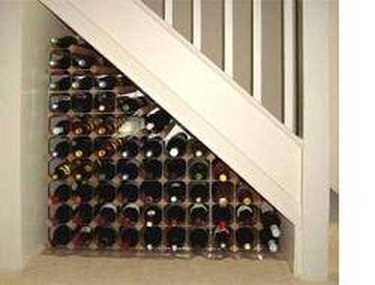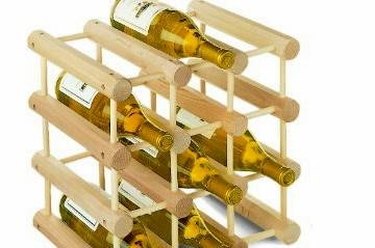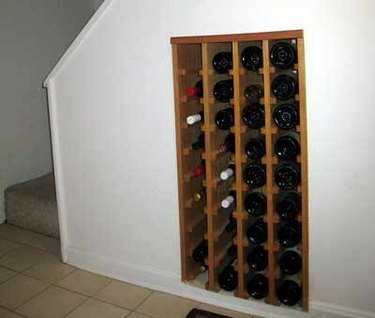Things You'll Need
Do-it-yourself or purchased table rack
Framing lumber
1/4-inch plywood for cabinet
Drill, screwdriver and wood screws
Wood glue (if using a do-it-yourself rack kit)
Saw
Trim for face
Stain or paint for finish

As we learn more about the wines we drink, we tend to collect those that we enjoy. A wine rack under the basement stairs is a perfect choice for the casual collector for a number of reasons. It's usually wasted space and is a natural choice for a wine "cellar" because the temperature is just about right and air circulation is limited. Light and humidity are easily controlled. As for vibration---the fifth variable in wine storage---unless you live in an earthquake zone, you've got no worries.
Step 1
Plan your project. If the stairway has closed sides, locate the studs that support the stairway and measure a space to open with a circular or jig saw. If the stairway is open, simply locate a convenient area between studs to install your wine cabinet. Measure the width, height and depth---height and width should exceed the size of your rack by 6 to 8 inches.
Video of the Day
Step 2

Find a ready-made table rack to fit your space or build your own with a kit, available at liquor stores and many home stores. You can customize a kit rack to fit the opening perfectly---it's also much less expensive.
Step 3

Frame in your cabinet. Cut four 2 by 4-inch pieces to attach between studs as side braces. Nail or screw these on the inside of the studs, one on the floor at the bottom and the other at the top of your cabinet. Cut one 2 by 4 for to go across the back of the cabinet on top of the side pieces so that it lays on top across the side frames---attach a 4-inch "block" of 2 by 4, 2 inches in from each end and attach this assembly across the top of the back of the cabinet box so the blocks hang next to the side braces. Cut a piece of two-by four the same length as the distance between the side braces and set aside.
Step 4

Fabricate your walls. Quarter-inch plywood is all you'll need. Sides should be set along the side braces along their length minus 3 7/8 inches (the width of a 2 by 4) in the back, sitting on the floor to flush with the top of the side braces. Measure the roof by taking the distance between the side braces and adding four inches (the roof will sit on top of the side braces and but up against the back brace). Lay the roof in and measure the back wall---floor to roof between the walls. Use a 2 by 4 at the bottom of the wall between the side walls to secure the back wall at the bottom---attach it with screws or use L-brackets with screws. Put construction adhesive along the tops of the walls and lift the roof in like a ceiling tile. Attach the back wall to the blocks and bottom brace with construction adhesive. Your cabinet is now enclosed on three sides.
Step 5
Finish the project by caulking the corners or lining with corner beading. Cut another piece of plywood to put on the floor if you wish. Be sure to seal any wood that will come in contact with the floor; better still, lay some moisture-resistant material that's used to line shower pans below the whole cabinet to protect the wood---and your wine from excess humidity. Insert the wine rack and finish the outer edges with one-by-four to frame with trim if desired. Paint the trim.
Tip
Most wine bottles are less than 16 inches tall but champagne magnums and certain Rhine wine bottles may be as tall as 20 inches, so plan on using most of the depth of the staircase for your rack. Create a few large spaces in your rack if you plan to store magnum (like champagne) or unusually-shaped bottles (like some Portuguese and Italian wines). Stain or paint kit racks (they usually come in unfinished pine) before assembly and glue pieces together as you go. Although you need do neither, gluing your rack avoids having to dig the whole thing out if a strut comes loose or breaks.
Warning
Always dry-fit pieces before nailing or gluing. Basements are cool but they may also be damp. In addition to using water-resistant wrap under your wine cabinet, you may want to invest in a hardware-store dehumidifier for the basement to ward off fungus and mold.
Video of the Day